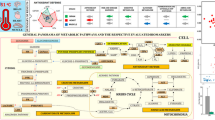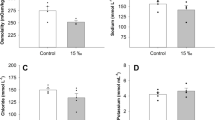Abstract
The Western painted turtle survives months without oxygen. A key adaptation is a coordinated reduction of cellular ATP production and utilization that may be signaled by changes in the concentrations of reactive oxygen species (ROS) and cyclic nucleotides (cAMP and cGMP). Little is known about the involvement of cyclic nucleotides in the turtle’s metabolic arrest and ROS have not been previously measured in any facultative anaerobes. The present study was designed to measure changes in these second messengers in the anoxic turtle. ROS were measured in isolated turtle brain sheets during a 40-min normoxic to anoxic transition. Changes in cAMP and cGMP were determined in turtle brain, pectoralis muscle, heart and liver throughout 4 h of forced submergence at 20–22°C. Turtle brain ROS production decreased 25% within 10 min of cyanide or N2-induced anoxia and returned to control levels upon reoxygenation. Inhibition of electron transfer from ubiquinol to complex III caused a smaller decrease in [ROS]. Conversely, inhibition of complex I increased [ROS] 15% above controls. In brain [cAMP] decreased 63%. In liver [cAMP] doubled after 2 h of anoxia before returning to control levels with prolonged anoxia. Conversely, skeletal muscle and heart [cAMP] remained unchanged; however, skeletal muscle [cGMP] became elevated sixfold after 4 h of submergence. In liver and heart [cGMP] rose 41 and 127%, respectively, after 2 h of anoxia. Brain [cGMP] did not change significantly during 4 h of submergence. We conclude that turtle brain ROS production occurs primarily between mitochondrial complexes I and III and decreases during anoxia. Also, cyclic nucleotide concentrations change in a manner suggestive of a role in metabolic suppression in the brain and a role in increasing liver glycogenolysis.



Similar content being viewed by others
References
Archer SL, Huang J, Henry T, Peterson D, Weir EK (1993) A redox-based O2 sensor in rat pulmonary vasculature. Circ Res 73:1100–1112
Barman SA, Zhu S, Han G, White RE (2003) cAMP activates BKCa channels in pulmonary arterial smooth muscle via cGMP-dependent protein kinase. Am J Physiol Lung Cell Mol Physiol 284:L1004–L1011
Ben-Haim G, Armstead WM (2000) Stimulus duration-dependent contribution of k(ca) channel activation and cAMP to hypoxic cerebrovasodilation. Brain Res 853:330–337
Bickler PE, Donohoe PH, Buck LT (2000) Hypoxia-induced silencing of NMDA receptors in turtle neurons. J Neurosci 20:3522–3528
Brooks SPJ, Storey KB (1990) cGMP-stimulated protein kinase phosphorylates pyruvate kinase in an anoxia-tolerant marine mullusc. J Comp Physiol B 160:309–316
Brooks SPJ, Storey KB (1993) Protein kinase C in turtle brain: changes in enzyme activity during anoxia. J Comp Physiol B 163:84–88
Buck LT (2000) Succinate and alanine as anaerobic end-products in the diving turtle (Chrysemys picta bellii). Comp Biochem Physiol B Biochem Mol Biol 126:409–413
Buck LT, Bickler P (1998) Adenosine and anoxia reduce N-methyl-D-aspartate receptor open probability in turtle cerebrocortex. J Exp Biol 201:289–297
Buck LT, Land SC, Hochachka PW (1993) Anoxia-tolerant hepatocytes: model system for study of reversible metabolic suppression. Am J Physiol (Regul Integr Comp Physiol) 265:R49–R56
Buescher PC, Pearse DB, Pillai RP, Litt MC, Mitchell MC, Sylvester JT (1991) Energy state and vasomotor tone in hypoxic pig lungs. J Appl Physiol 70:1874–1881
Carini R, Grazia De Cesaris M, Splendore R, Domenicotti C, Nitti MP, Pronzato MA, Albano E (2003) Signal pathway responsible for hepatocyte preconditioning by nitric oxide. Free Radic Biol Med 34:1047–1055
Chen J, Zhu JX, Wilson I, Cameron JS (2005) Cardioprotective effects of K ATP channel activation during hypoxia in goldfish Carassius auratus. J Exp Biol 208:2765–2772
Choi Y, Chen HV, Lipton SA (2001) Three pairs of cysteine residues mediate both redox and zn2+ modulation of the nmda receptor. J Neurosci 21:392–400
Clark VM, Miller AT Jr (1973) Studies on anaerobic metabolism in the fresh-water turtle (Pseudemys scripta elegans). Comp Biochem Physiol A 44:55–62
Cross JV, Templeton DJ (2006) Regulation of signal transduction through protein cysteine oxidation. Antioxid Redox Signal 8:1819–1827
Doll C, Hochachka P, Hand S (1994) A microcalorimetric study of turtle cortical slices: insights into brain metabolic depression. J Exp Biol 191:141–153
Fujii T, Baumgartl H, Lubbers DW (1982) Limiting section thickness of guinea pig olfactory cortical slices studied from tissue pO2 values and electrical activities. Pflugers Arch 393:83–87
Ghai HS, Buck LT (1999) Acute reduction in whole cell conductance in anoxic turtle brain. Am J Physiol 277:R887–R893
Giordano FJ (2005) Oxygen, oxidative stress, hypoxia, and heart failure. J Clin Invest 115:500–508
Hochachka PW (1986) Defense strategies against hypoxia and hypothermia. Science 231:234–241
Jackson DC (1968) Metabolic depression and oxygen depletion in the diving turtle. J Appl Physiol 24:503–509
Jayalakshmi K, Sairam M, Singh SB, Sharma SK, Ilavazhagan G, Banerjee PK (2005) Neuroprotective effect of N-acetyl cysteine on hypoxia-induced oxidative stress in primary hippocampal culture. Brain Res 1046:97–104
Kourie JI (1998) Interaction of reactive oxygen species with ion transport mechanisms. Am J Physiol 275:C1–C24
Kudin AP, Bimpong-Buta NY, Vielhaber S, Elger CE, Kunz WS (2004) Characterization of superoxide-producing sites in isolated brain mitochondria. J Biol Chem 279:4127–4135
Land SC, Buck LT, Hochachka PW (1993) Response of protein synthesis to anoxia and recovery in anoxia-tolerant hepatocytes. Am J Physiol (Regul Integr Comp Physiol) 34:R41–R48
Liu Y, Fiskum G, Schubert D (2002) Generation of reactive oxygen species by the mitochondrial electron transport chain. J Neurochem 80:780–787
Lopez-Barneo J, del Toro R, Levitsky KL, Chiara MD, Ortega-Saenz P (2004) Regulation of oxygen sensing by ion channels. J Appl Physiol 96:1187–1195; discussion 1170–1182
Mehrani H, Storey KB (1995a) cAMP-dependent protein kinase and anoxia survival in turtles: purification and properties of liver PKA. Mol Cell Biochem 145:81–88
Mehrani H, Storey KB (1995b) Enzymatic control of glycogenolysis during anoxic submergence in the freshwater turtle Trachemys scripta. Int J Biochem Cell Biol 27:821–830
Michaelidis B, Storey KB (1990) Phosphofructokinase from the anterior byssus retractor muscle of mytilus edulis: modification of hte enzyme in anoxia and by endogenous protein kinases. Int J Biochem 22:759–765
Mohazzab KM, Fayngersh RP, Kaminski PM, Wolin MS (1995) Potential role of NADH oxidoreductase-derived reactive O2 species in calf pulmonary arterial PO2-elicited responses. Am J Physiol 269:L637–L644
Mohazzab KM, Wolin MS (1994) Sites of superoxide anion production detected by lucigenin in calf pulmonary artery smooth muscle. Am J Physiol 267:L815–L822
Nilsson G, Lutz P (1992) Adenosine release in the anoxic turtle brain: a possible mechanism for anoxic survival. J Exp Biol 162:345–351
Nilsson GE, Lutz PL (1991) Release of inhibitory neurotransmitters in response to anoxia in turtle brain. Am J Physiol 261:R32–R37
Palmer GC (1985) Cyclic nucleotides in stroke and related cerebrovascular disorders. Life Sci 36:1995–2006
Perez-Pinzon MA, Rosenthal M, Sick TJ, Lutz PL, Pablo J, Mash D (1992) Downregulation of sodium channels during anoxia: a putative survival strategy of turtle brain. Am J Physiol (Regul Integr Comp Physiol) 262:R712–R715
Qin Q, Yang XM, Cui L, Critz SD, Cohen MV, Browner NC, Lincoln TM, Downey JM (2004) Exogenous NO triggers preconditioning via a cGMP- and mitoKATP-dependent mechanism. Am J Physiol Heart Circ Physiol 287:H712–H718
Ramaglia V, Buck LT (2004) Time-dependent expression of heat shock proteins 70 and 90 in tissues of the anoxic western painted turtle. J Exp Biol 207:3775–3784
Rhee S, Chang T, Bae Y, Lee S, Kang S (2003) Cellular regulation by hydrogen peroxide. J Am Soc Nephrol 14:s211–s215
Rounds S, McMurtry IF (1981) Inhibitors of oxidative ATP production cause transient vasoconstriction and block subsequent pressor responses in rat lungs. Circ Res 48:393–400
Shin DS, Wilkie MP, Pamenter ME, Buck LT (2005) Calcium and protein phosphatase 1/2A attenuate N-methyl-D-aspartate receptor activity in the anoxic turtle cortex. Comp Biochem Physiol A Mol Integr Physiol 142:50–57
Sick TJ, Rosenthal M, Lutz PL (1984) Mechanisms of brain survival in anoxia: mitochondrial activity and ion homeostasis in turtle and rat. Adv Exp Med Biol 180:221–231
Ultsch GR, Jackson DC (1982) Long-term submergence at 3 degrees C of the turtle Chrysemys picta bellii in normoxic and severely hypoxic water III. Effects of changes in ambient PO2 and subsequent air breathing. J Exp Biol 97:87–99
Vanden Hoek TL, Becker LB, Shao Z, Li C, Schumacker PT (1998) Reactive oxygen species released from mitochondria during brief hypoxia induce preconditioning in cardiomyocytes. J Biol Chem 273:18092–18098
Wang ZW, Nara M, Wang YX, Kotlikoff MI (1997) Redox regulation of large conductance Ca(2+)-activated K+ channels in smooth muscle cells. J Gen Physiol 110:35–44
Waypa GB, Chandel NS, Schumacker PT (2001) Model for hypoxic pulmonary vasoconstriction involving mitochondrial oxygen sensing. Circ Res 88:1259–1266
Whitwam RE, Storey KB (1990a) Pyruvate kinase from the land snail otala lactea: regulation by reversible phophorylation during estivation and anoxia. J Exp Biol 154:321–337
Whitwam RE, Storey KB (1990b) Regulation of phosphfructokinase during estivation and anoxia in the land snail otala lactea. Physiol Zool 64:595–610
Acknowledgments
We would like to thank Dr. Milt Charlton for his advice regarding fluorescent recordings, and the use of his fluorescent microscopy system. This research was supported by an NSERC discovery grant to LTB. All Experiments comply with the “Principles of animal care,” publication No. 86-23, revised 1985 of the National Institute of Health, and also with the current laws of Canada.
Author information
Authors and Affiliations
Corresponding author
Additional information
Communicated by H.V. Carey.
Rights and permissions
About this article
Cite this article
Pamenter, M.E., Richards, M.D. & Buck, L.T. Anoxia-induced changes in reactive oxygen species and cyclic nucleotides in the painted turtle. J Comp Physiol B 177, 473–481 (2007). https://doi.org/10.1007/s00360-007-0145-8
Received:
Revised:
Accepted:
Published:
Issue Date:
DOI: https://doi.org/10.1007/s00360-007-0145-8




